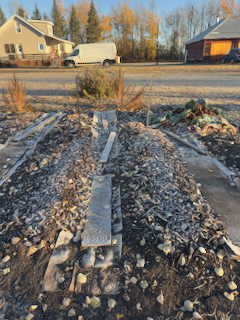| Back to Back Issues Page |
 |
|
Vegetable Gardening Hints, November 2025 November 01, 2025 |
Hello, Turn Fall Leaves into Garden Gold: How to Make Leaf Mould As the trees shed their autumn leaves, most people see a mess to rake up. But savvy gardeners know those leaves are worth their weight in compost!
As the trees shed their autumn leaves, most people see a mess to rake up. But savvy gardeners know those leaves are worth their weight in compost!
If you want a simple, no-fuss way to improve your soil naturally, start making leaf mould this fall. 🍂 What Is Leaf Mould?Leaf mould is the result of decomposed leaves — a crumbly, dark, earthy material that’s rich in organic matter.Unlike compost, which relies on bacteria and nitrogen-rich materials to break down, leaf mould is made almost entirely by fungi slowly breaking down leaves. It doesn’t add a lot of nutrients, but it’s incredible for improving soil structure, moisture retention, and microbial life. In short: compost feeds your plants, leaf mould feeds your soil. 🪴 Why You Should Make Leaf Mould1. Moisture retention: Adding leaf mould helps your soil hold water, reducing the need for frequent watering in summer.2. Soil health: It makes heavy clay lighter and sandy soil more cohesive. 3. Free mulch: Spread it over your beds in spring or fall to protect and enrich the soil. 4. Eco-friendly: It keeps leaves out of landfills and gives them a second life in your garden. 
🧺 How to Make Leaf MouldYou only need three things: leaves, moisture, and time.Step 1: Collect your leaves Gather dry leaves with a rake or mulching mower. Avoid adding evergreen needles, black walnut, or eucalyptus leaves — they take longer to break down or can affect soil chemistry. Step 2: Shred them (optional) Shredding speeds up decomposition. You can run over them with your mower or use a leaf shredder. Step 3: Store them Pile the leaves in a wire bin, compost cage, or large garbage bag with holes poked in the sides. Dampen them as you go — they should feel like a wrung-out sponge. Step 4: Wait Place your pile or bags in a shady corner and let the fungi do their work. • After 6 months, you’ll have partially rotted leaves — great as mulch. • After 12–18 months, you’ll have dark, crumbly leaf mould ready to mix into garden beds. 🌱 How to Use Leaf Mould• Mulch: Spread 2–3 inches around your vegetables or perennials to suppress weeds and retain moisture.• Soil improver: Work it into garden beds in spring before planting. • Potting mix: Combine with compost and perlite for a rich, moisture-holding seed mix. 🧠 Pro TipIf you live in a cold region, keep your leaf pile slightly damp and cover it with burlap or a tarp over winter to hold in moisture. The process slows during freezing weather but picks up again in spring.
🍃 Final ThoughtsLeaf mould might take time to form, but it’s one of the easiest and most rewarding soil amendments you can make — and it costs nothing but a bit of patience.This fall, instead of bagging up those leaves, let them turn into “garden gold” for next year’s crops. 
For videos Subscribe to my NEW youtube channel:Your Veggie Helper YoutubeNew to gardening? Design Plans to get started:Vegetable Garden Plans for your Rasised BedsVegetable Garden Plans for Square foot Gardens Vegetable Garden Plans for Row Gardening Join my facebook groupI would love to hear why you garden. Also, if you have any questions or comments please check out my Facebook group and lets chat. www.facebook.com/groups/veggiegardenhelperSpread the wordGet everyone growing a few of their own veggies. Forward this FREE ezine to a friend. Happy gardening!Catherine |
| Back to Back Issues Page |